Learn how to make the best scones recipe that results in flaky, buttery scones that have a moist center with crispy edges. Enjoy them fresh from the oven for breakfast or brunch!
Far from dry and bland the best scone is moist and tender! Other favorites include these glazed orange scones, blueberry scones and Irish scones.
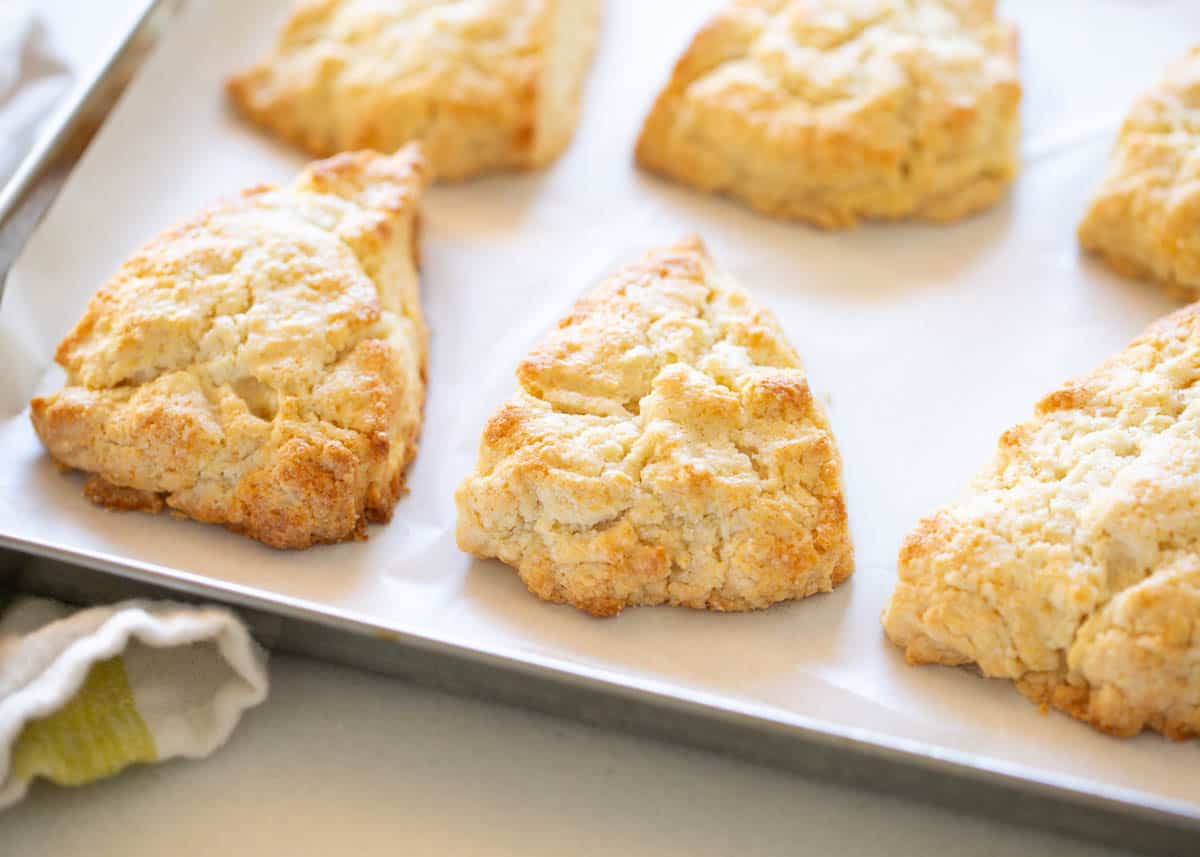
This post may contain affiliate links. Read disclosure policy.
Classic Scones
There’s something undeniably magical about the aroma of freshly baked scones wafting through the kitchen. For my family, scones are a cherished treat, and we’ve made it a delightful tradition to enjoy them warm and straight from the oven.
Today, we’re diving into the world of scones and I’ll walk you through a simple yet fantastic scone recipe that’s bound to become your go-to.
Whether it’s a lazy Sunday morning, a special afternoon tea, or a spontaneous craving, scones can transform any moment into a cozy, indulgent experience!
Scone Recipe Ingredients
These scones use easy-to-find ingredients that you can keep on hand so you can whip up a batch whenever you want!
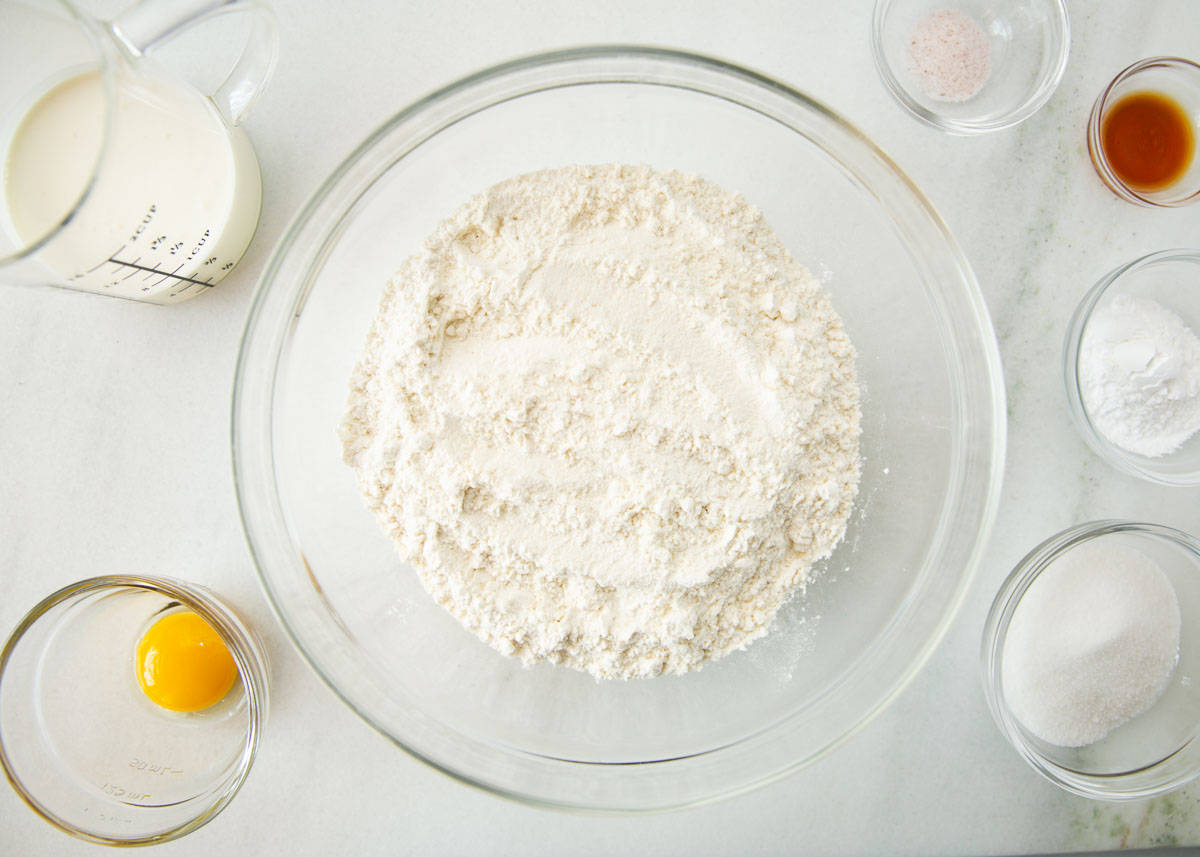
Find the full printable recipe with specific measurements below.
For the Scones:
- Heavy cream: While heavy cream gives these scones their richness, you can substitute it with buttermilk for a slightly tangy flavor or whole milk for a lighter option.
- Egg yolk: You can store the egg white in the fridge for another purpose. To use them up, I like to add extra whites to my scrambled eggs.
- All-purpose flour: All-purpose flour is typically used in scone recipes, but you can experiment with different types of flour for unique textures. Cake flour will make your scones more delicate, while whole wheat flour will add a hearty, nutty flavor. No matter which flour you use, it’s important to measure your flour accurately.
- Unsalted butter: Make sure the butter is cold from the fridge. It needs to be cold to help achieve a flaky texture.
- Mix-ins: You can add some dried fruit, chocolate chips, or nuts, but these are optional.
For the Glaze:
I use a simple glaze of melted butter, powdered sugar and half-and-half. You can also try this other powdered sugar glaze if you prefer.
Scone Flavor Variations
Now that you’ve mastered the classic scone recipe, why not experiment with different flavors? The basic dough can easily incorporate different flavors and mix-ins! Here are a few ideas to inspire you:
- Sugar topping: Brush the scones with heavy cream and then sprinkle 1 tablespoon of coarse sugar (demerara) over the tops right before baking. This adds a lovely, caramelized touch.
- Cream cheese glaze: Instead of the regular glaze, whip up a cream cheese glaze with a touch of lemon zest for a tangy twist.
- Citrus: Add some freshly grated orange zest to the dough and top the scones with a zesty orange glaze.
- Pumpkin spiced scones: Incorporate some pumpkin puree and a blend of warm spices like cinnamon, nutmeg, and cloves for a cozy fall treat.
- Berry scones: Add fresh berries to the dough like blueberries, strawberries, or cranberries.
- Dried fruit and buttermilk: Swap heavy cream for buttermilk and add raisins or currants for a traditional Irish scone experience.
Now, you can mix up your scone variations to match any occasion!
How to Make Scones
If you’ve ever wondered how to make scones with flaky layers, a tender crumb, and bursting with flavor, you’re in the right place!
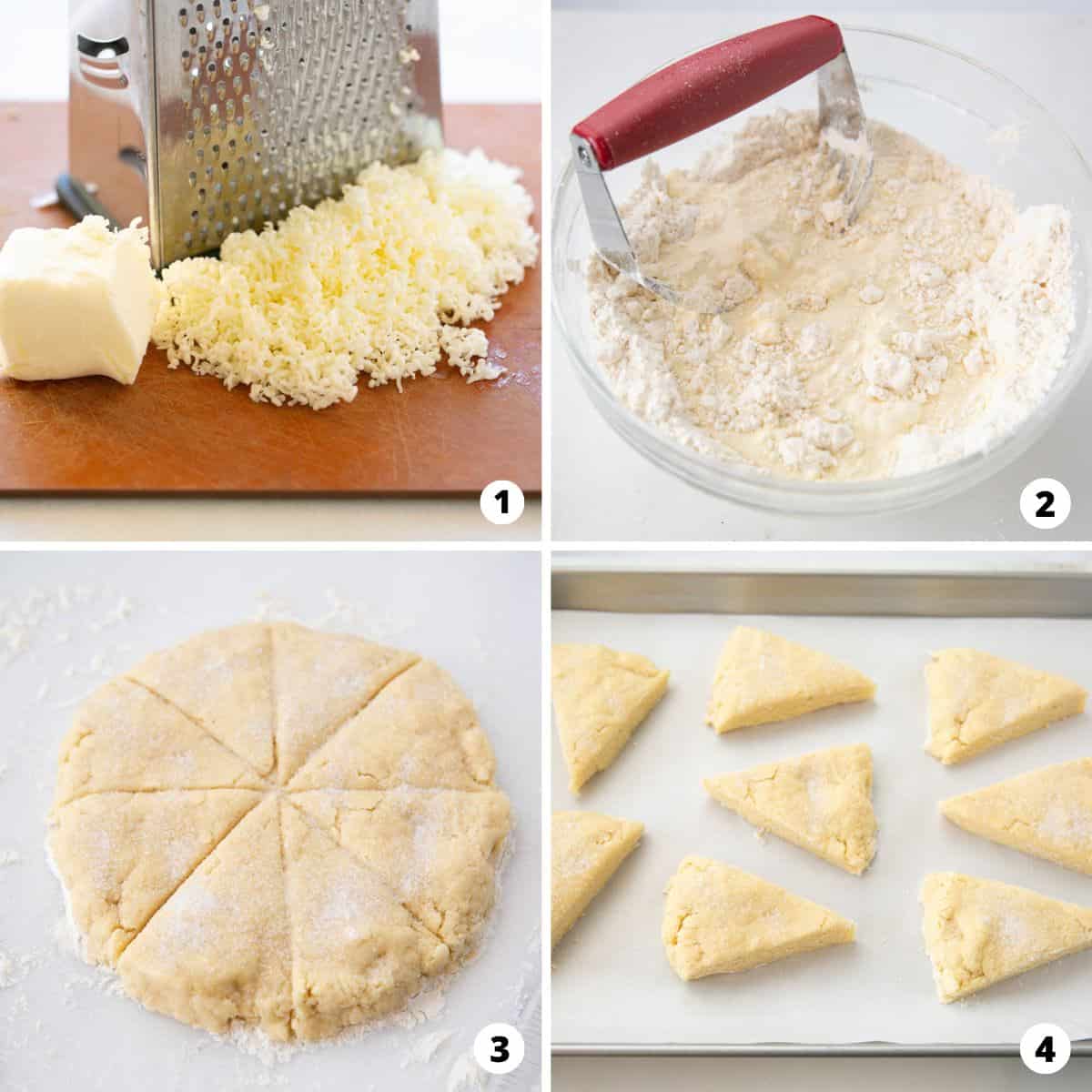
- Cut the butter. Grate a frozen stick of butter. Or you can cube the butter into 1/4-inch pieces. Then place back into the freezer until ready to use.
- Combine dry ingredients. In a large mixing bowl or using a food processor, whisk or pulse together the flour, sugar, baking powder, and salt. Cut in the cold butter until the flour mixture resembles coarse crumbs. This step is crucial for achieving that lovely flakiness. The slowly mix in cream mixture.
- Chill the dough. Press the scone dough into an 8-inch disk and place in the freezer for about 10 minutes to chill.
- Shape, cut, & bake. On a lightly-floured work surface, gently shape the dough into a circle then cut into 8 wedges. Brush the top with cream. Pop these beauties in the oven for 5 minutes, or until the edges are golden brown. Once done, transfer them to a cooling rack to cool.
To Make the Glaze, whisk together the melted butter, powdered sugar, and half-and-half in a small bowl until smooth. Add a little more half-and-half if needed to achieve a pourable yet thick consistency. Drizzle the glaze over your cooled scones.
Making Scones Recipe Ahead of Time
One of the great things about this recipe for scones is that you can prepare them ahead of time for a stress-free morning or an impromptu brunch with friends!
Simply follow the recipe up to the point where you’ve cut the dough into triangles. Instead of baking immediately, wrap them up and store them in the refrigerator overnight. When you’re ready to enjoy them, pop them in the oven for a freshly baked treat without the morning rush.
You can also freeze unbaked scones. When you’re ready to bake, put them directly into the oven. You may need to add a couple of extra minutes to the baking time.
Expert Tips
- Keep ingredients cold. Cold ingredients, especially butter and cream, are key to achieving flaky scones. Make sure your butter is cold and cut it into small pieces before incorporating it into the dry ingredients. Likewise, use cold heavy cream.
- Don’t overwork the dough. When mixing the dough, be gentle. Overworking the dough can lead to tough scones. Mix just until the ingredients come together, and it’s okay if there are some visible butter pieces in the dough.
- Uniform sizing. Try to make sure your scones are all the same size and thickness. This ensures even baking.
- Chill before baking. After shaping the dough and cutting it into triangles, place the scones in the freezer for about 10-15 minutes before baking. This extra chilling time helps the scones hold their shape and rise beautifully without the butter spreading.
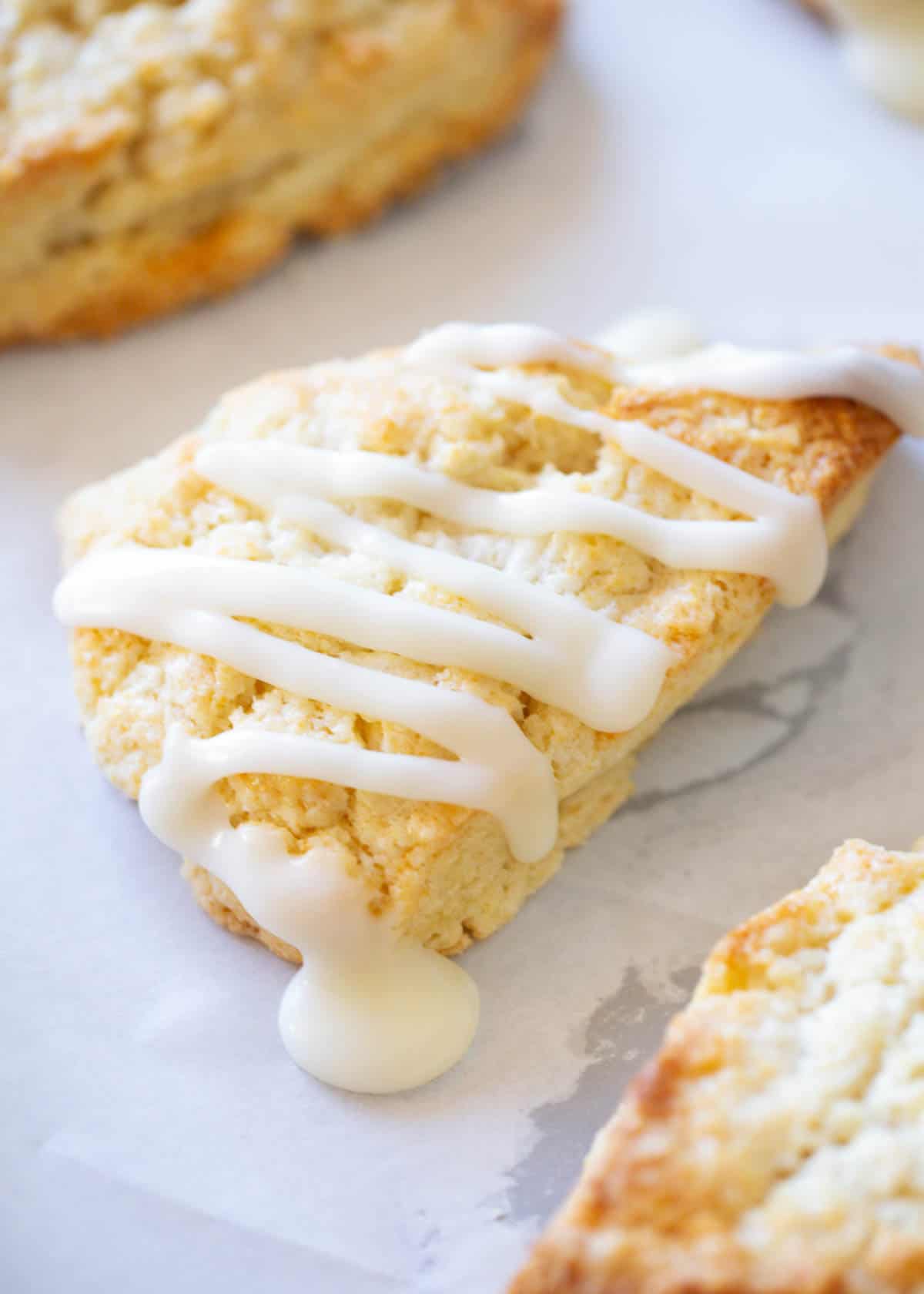
Recipe FAQs
Scones are sweetened and often include sugar, eggs, and ingredients like dried fruits, making them dessert-like.
Homemade biscuits, on the other hand, are savory, typically made with flour, baking powder, salt, and butter or shortening, and lack sugar and eggs in traditional recipes.
Absolutely! If you don’t have a food processor or pastry cutter, you can use your fingertips to rub the cold butter into the dry ingredients. Just work quickly to avoid warming the butter too much.
Dry or crumbly scones can result from over mixing the dough, using too little liquid, or baking them for too long. Be sure to mix the dough just until it comes together, and don’t overbake the scones. You can also add a bit more cream if the dough seems too dry.
To achieve flakier scones, ensure your butter is cold, and don’t overmix the dough. Some bakers even freeze the butter and grate it into the dry ingredients for extra flakiness.
If your scones spread excessively, it may be due to warm butter or overmixing. To prevent this, make sure your butter is cold, and be gentle when combining the ingredients. Chilling the dough before baking can also help.
It’s best to freeze scones without the glaze as the glaze can become watery when thawing. Instead, make and freeze the scones, then glaze them after thawing.
Storing
Keep your scones in an airtight container or bag at room temperature for 1-2 days. They’re best when fresh, but you can always give them a quick warm-up in the oven to revive their flakiness.
Freezing: If you want to enjoy your scones at a later date, wrap them individually in plastic wrap and store them in a freezer bag or container. They’ll keep well in the freezer for up to 1 month. Just remember to thaw them before serving.
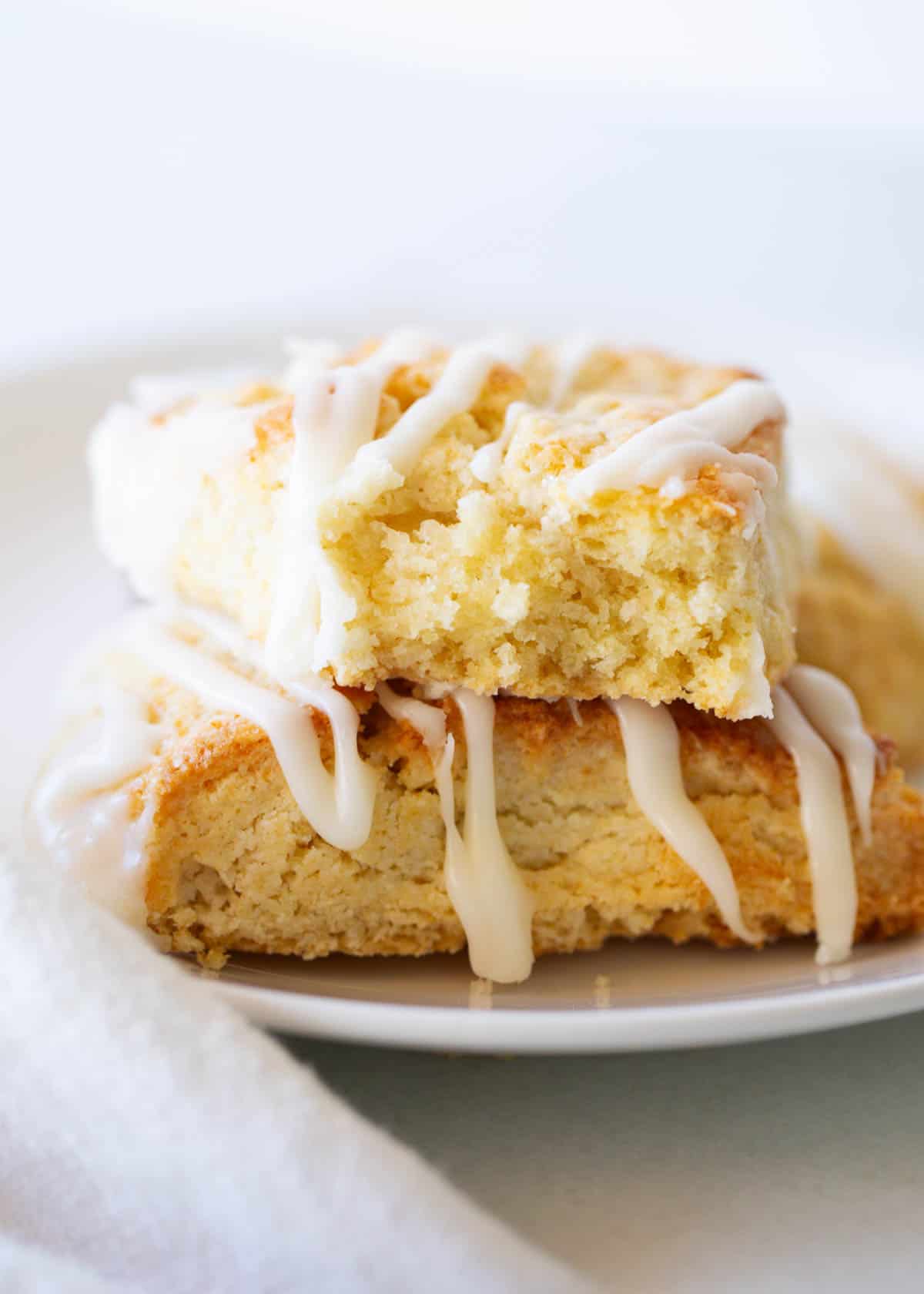
You might also love these easy recipes including homemade pound cake, cinnamon crescent rolls or these orange sweet rolls!
More Recipes You’ll Love
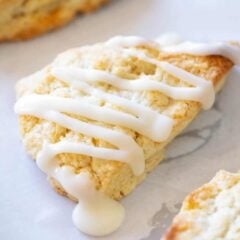
Best Scones Recipe
Video
Ingredients
Scone:
- ½ cup (1 stick; 113 g) unsalted butter , cold
- ½ cup heavy cream , plus more for brushing on top if desired
- 1 teaspoon vanilla extract
- 1 egg yolk , whisked
- 2 cups (260 g) all-purpose flour
- ⅓ cup (75 g) granulated sugar
- 1 Tablespoon baking powder
- ½ teaspoon fine sea salt
- 1/2-1 cup dried fruit, chocolate chips, or nuts (optional)
Glaze
- 1 Tablespoon unsalted butter , melted
- ¾ cup powdered sugar
- 1-2 Tablespoons half-and-half
Instructions
- Cube the butter into 1/4-inch pieces. Then place back into the freezer until ready to use. You can also grate a frozen stick of butter.
- In a large bowl or a food processor, whisk or pulse together the flour, sugar, baking powder, and salt. Pulse or using a pastry cutter or 2 forks, cut in the butter until the flour mixture resembles coarse crumbs.
- In a small bowl, whisk together the heavy cream, vanilla, and egg yolk. Then drizzle over the flour mixture and add any mix-in's if desired. Stir just until combined, being careful not to over mix. Don’t try to get the dough completely smooth; you want to avoid over working the dough (it should be a little crumbly). You can add an extra Tablespoon of cream if needed to combine.
- Place the dough on a parchment paper. Gently press the dough into an 8-inch disk about 1-inch thick. The place in the freezer for 10 minutes to chill.
- Preheat the oven to 400°F. Line a large baking sheet with parchment paper or a silicone mat.
- Using a sharp knife or pizza cutter, cut the circle into 8 wedges. For petite scones you can cut those wedges in half to make 16 smaller triangles. Place on baking sheet at least 1-inch apart. Brush the top with heavy cream and sprinkle with coarse sugar.
- Bake 13 to 15 minutes for smaller scones and 18-20 minutes for larger scones, or until the tops are golden brown. Transfer to a cooling rack to cool.
Glaze
- In a small bowl, whisk together the melted butter, powdered sugar, and half-and-half until smooth. Add 1 Tablespoon half-and-half, if needed, to make the glaze pourable but still thick. Drizzle on top of cooled scones.
Last step: Please leave a comment and rating after you make the recipe.
Notes
Nutrition
Nutrition provided is an estimate. It will vary based on specific ingredients used.




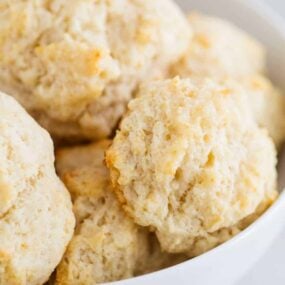
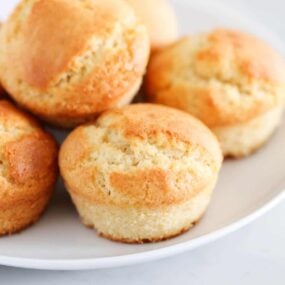
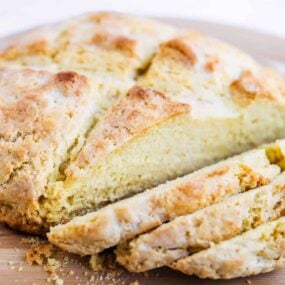

Toni
Everyone at my house loved these comforting scones! I will definitely make it again!
Kristyn
So soft & crumbly, they just melt in your mouth!! There’s nothing better than a scone & that glaze is simple & delicious!
Kara
I grated a frozen stick of butter like you suggested. The scones turned out perfectly, and the glaze makes them extra decadent! I can’t wait to experiment with other flavors.